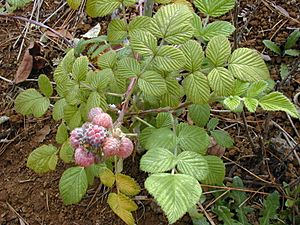Rubus niveus facts for kids
Quick facts for kids Rubus niveus |
|
|---|---|
 |
|
| Scientific classification | |
| Genus: |
Rubus
|
| Species: |
niveus
|
| Synonyms | |
|
Synonymy
Dyctisperma lasiocarpus (Sm.) Raf. ex B.D.Jacks.
Rubus albescens Roxb. Rubus bonatii H.Lév. Rubus distans D.Don Rubus donianus Spreng. Rubus foliolosus D.Don Rubus godongensis Y.Gu & W.L.Li Rubus incanus Sasaki ex T.S.Liu & T.Y.Yang Rubus lasiocarpus Sm. Rubus lasiocarpus var. micranthus (D.Don) Hook.f. Rubus longistylus H.Lév. Rubus micranthus D.Don Rubus mysorensis B.Heyne Rubus pinnatus D.Don Rubus pyi H.Lév. Rubus tongtchouanensis H.Lév. Rubus concolor Wall. Rubus horsfieldii Miq. Rubus sericeus Lindl. |
|
Rubus niveus, also known as the Mysore raspberry or Ceylon raspberry, is a type of plant. People also call it the hill raspberry. In some parts of Asia, it has other names like hong pao ci teng (Chinese) and kala hinsalu (Hindi).
This plant is originally from southern Asia. You can find it from Afghanistan all the way east through India and China. It also grows in Taiwan, the Philippines, Sri Lanka, and Malaysia. Its northern reach is up to Gansu in China.
What Does the Mysore Raspberry Look Like?
The Mysore raspberry is a shrub, which is a bushy plant. It usually grows to be about 1 to 2.5 meters (3 to 8 feet) tall.
When the stems are young, they are covered in soft, white, hair-like fibers. This makes them look whitish. As they get older, these stems become smooth and turn green or purple.
The leaves of this plant are special. They are "pinnate," meaning they have smaller leaflets arranged along a central stem, like a feather. Each leaf usually has 5 to 11 leaflets, but most often 7 or 9.
These leaflets are about 2.5 to 8 centimeters (1 to 3 inches) long. They are also 1 to 4 centimeters (0.4 to 1.6 inches) wide. The top side of the leaflets is dark green. The underside is covered in thick, pale grey to white, soft fibers.
The flowers of the Mysore raspberry are small, about 1 centimeter (0.4 inches) across. They have five petals that are a dark pink to red color.
After the flowers, the plant produces fruit. The fruit is round, about 8 to 12 millimeters (0.3 to 0.5 inches) wide. It is also covered in dense, grey, soft fibers. When the fruit first appears, it is dark red. As it ripens, it turns black.
Where Does the Mysore Raspberry Grow and Why Is It Important?
People grow Rubus niveus because its fruit is tasty and can be eaten. It's a popular fruit in many places where it grows naturally.
However, this plant has also spread to new areas. When a plant grows in a new place where it wasn't originally found, it's called "naturalized." Sometimes, these naturalized plants can become "invasive."
An invasive species is a plant or animal that spreads quickly in a new environment. It can harm the local plants and animals by taking over their space and resources. The Mysore raspberry has become an invasive plant in places like Hawaii and the Galápagos Islands. This means it is growing too much there and causing problems for the native plants.
See also
 In Spanish: Rubus niveus para niños
In Spanish: Rubus niveus para niños

